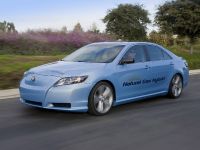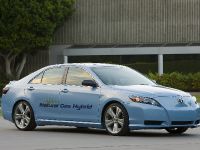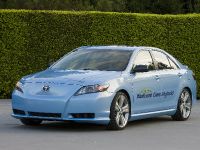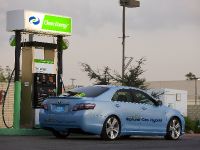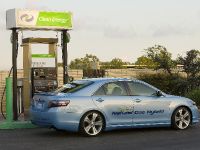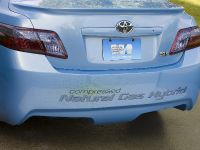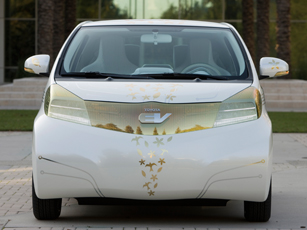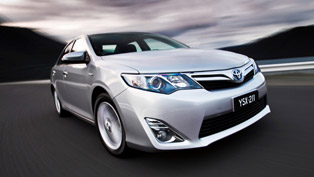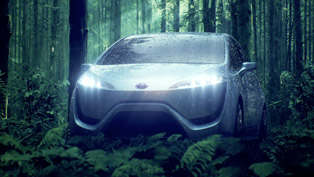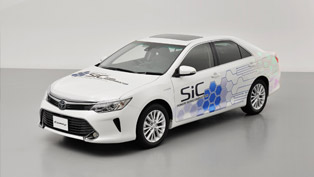CNG-Powered Camry Hybrid Concept At 2008 Los Angeles Auto Show
Toyota Motor Sales (TMS), U.S.A., Inc., today highlighted the versatility of its Hybrid Synergy Drive® system by showing a compressed natural gas (CNG) Camry Hybrid concept vehicle at the 2008 Los Angeles Auto Show.
"In the near future, growing demand for liquid petroleum simply and effectively will exceed supply," said Chris Hostetter, group vice president, TMS Advanced Product Strategy. "Before that occurs, automakers must look to vehicles powered by alternative fuels. We believe CNG will be one of those alternatives."
The current CNG benefits are amplified by rapidly changing market conditions and an increase in consumer environmental awareness. As a transport fuel, natural gas is a clean and safe gasoline alternative. It can potentially reduce U.S. dependency on foreign oil and reduce vehicle operating costs. Currently more than 99 percent of natural gas used in the U.S. comes from domestic & other North American sources. Proven worldwide natural gas reserves are estimated to last until 2100 and have the potential to last until 2200 through improved advanced production methods.
Natural gas also produces lower particulate emissions, nitrous oxide (NOx), carbon monoxide (CO), carbon dioxide (CO2) and non-methane organic gases (NMOG), and less CO2 per unit of energy when compared with gasoline. In addition, it has a higher flash point (ignition temperature) than gasoline, can run at a higher compression ratio and is quickly dispersed into the atmosphere, should a leak occur.
The CNG Camry Hybrid concept was designed by the TMS Advanced Product Strategy group and built by Metal Crafters of Fountain Valley, Calif. To convert the stock Camry Hybrid to a CNG vehicle, the gasoline fuel system was replaced with a CNG system including two CNG tanks installed in the spare tire well area.
The exterior of the vehicle also received some sporty ‘concept' touches. A sleek custom front fascia and front bumper cover eliminate the grill opening, while a custom rear bumper covers the tail pipe and visible exhaust system. The vehicle is fitted with 19 x 7.5 alloy wheels and Bridgestone Potenza 225/35ZR19 run-flat tires to accommodate the lack of a spare tire. The overall ride height is lowered while new side body skirts and "Compressed Natural Gas Hybrid" graphics complete the unique look.
In 1999, Toyota marketed a CNG-powered four-cylinder Camry to fleet customers in California. Due to relatively low gasoline costs at that time, customers were not attracted to a vehicle that required special refueling techniques and a limited refueling infrastructure. The program was discontinued a year later. Today there are less than 1,000 CNG refueling stations nationwide, with less than half open to the public.
"Toyota believes CNG has huge potential, both in the U.S. and globally," said Hostetter, "but CNG is just one of the many alternative fuels we're exploring in our ongoing advanced technology research and development."
TOYOTA CNG CAMRY HYBRID CONCEPT PRELIMINARY SPECIFICATIONS
POWERTRAIN 2.4 liter, 4-cylinder engine with Toyota Hybrid Synergy Drive® Gasoline fuel system replaced with CNG system
ESTIMATED FUEL ECONOMY (mpg) City/Highway/Combined = 32/34/33 (Gasoline Camry Hybrid = 33/34/34)
NET HORSEPOWER (Engine + Electric Motor + Generator + Power Storage) 170 hp
CNG SYSTEM •Two (2) Lincoln composite Type 4 tanks - plastic liner with carbon fiber wrapped exterior •Tanks installed in spare tire well area •Maximum 3,600 psi
CAPACITY Proposed 8 gallon gasoline equivalent
RANGE 250+ miles
DIMENSIONS (inches) Overall Length: 191.2 Overall Width: 71.7 Overall Height: 57.5 Wheelbase: 109.3 Wheel Size: 19 x 7.5 alloy wheels
